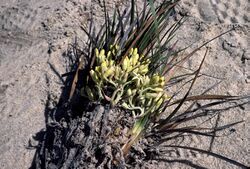Biology:Conostylis phathyrantha
| Conostylis phathyrantha | |
|---|---|

| |
| Near Cape Arid National Park | |
| Scientific classification | |
| Kingdom: | Plantae |
| Clade: | Tracheophytes |
| Clade: | Angiosperms |
| Clade: | Monocots |
| Clade: | Commelinids |
| Order: | Commelinales |
| Family: | Haemodoraceae |
| Genus: | Conostylis |
| Species: | C. phathyrantha
|
| Binomial name | |
| Conostylis phathyrantha Diels[1]
| |
Conostylis phathyrantha is a rhizomatous, tufted perennial, grass-like plant or herb in the family Haemodoraceae and is endemic to the south of Western Australia. It has flat, glabrous leaves, and yellow, tubular flowers.
Description
Conostylis phathyrantha is a rhizomatous, tufted, perennial, grass-like plant or herb with short stems. Its leaves are flat, curved, 130–300 mm (5.1–11.8 in) long, 3–6 mm (0.12–0.24 in) wide and glabrous, apart from pimply leaf margins. The flowers are borne in heads on a flowering stem 60–160 mm (2.4–6.3 in) long with a linear bract 10–50 mm (0.39–1.97 in) long and several flowers, each flower on a pedicel about 5 mm (0.20 in) long. The perianth is 12–15 mm (0.47–0.59 in) long and yellow, with lobes about 5 mm (0.20 in) long, the anthers about 2 mm (0.079 in) long. Flowering occurs from August to October.[2][3][4]
Taxonomy and naming
Conostylis phathyrantha was first formally described in 1904 by Ludwig Diels in Botanische Jahrbücher für Systematik, Pflanzengeschichte und Pflanzengeographie from specimens collected by Sarah Brooks near Israelite Bay.[5][6] The specific epithet (phathyrantha) means "sun-flowered".[7]
Distribution and habitat
This conostylis grows in sand in heath and mallee heath between Starvation Boat Harbour and Israelite Bay in the Esperance Plains and Mallee bioregions of southern Western Australia.[2][4]
Conservation status
Conostylis phathyrantha is listed as "not threatened" by the Government of Western Australia Department of Biodiversity, Conservation and Attractions.[2]
References
- ↑ "Conostylis phathyrantha". Australian Plant Census. https://biodiversity.org.au/nsl/services/apc-format/display/77640.
- ↑ 2.0 2.1 2.2 "Conostylis phathyrantha". FloraBase. Western Australian Government Department of Parks and Wildlife. https://florabase.dpaw.wa.gov.au/browse/profile/1445.
- ↑ Hopper, S.D; Purdie, R.W; George, A.S; Patrick, S.J. "Conostylis phathyrantha". Australian Biological Resources Study, Department of Agriculture, Water and the Environment. https://profiles.ala.org.au/opus/foa/profile/Conostylis%20phathyrantha.
- ↑ 4.0 4.1 Hopper, S.D; Purdie, R.W; George, A.S; Patrick, S.J. "Conostylis phathyrantha". Australian Biological Resources Study, Department of Agriculture, Water and the Environment. pp. 102–103. https://www.dcceew.gov.au/sites/default/files/env/pages/34b53009-bdf7-4c4d-93a6-4a9ab3c14cf7/files/flora-australia-45-hydatellaceae-liliaceae.pdf.
- ↑ "Conostylis phathyrantha". APNI. https://biodiversity.org.au/nsl/services/api/instance/apni/491854.
- ↑ Diels, Ludwig (1904). "Fragmenta Phytographiae Australiae occidentalis. Beitrage zur Kenntnis der Pflanzen Westaustraliens, ihrer Verbreitung und ihrer Lebensverhaltnisse.". Botanische Jahrbücher für Systematik, Pflanzengeschichte und Pflanzengeographie 35 (1): 111. https://www.biodiversitylibrary.org/item/660#page/116/mode/1up. Retrieved 8 January 2024.
- ↑ Sharr, Francis Aubi; George, Alex (2019). Western Australian Plant Names and Their Meanings (3rd ed.). Kardinya, WA: Four Gables Press. p. 275. ISBN 9780958034180.
Wikidata ☰ Q15333583 entry
 |

